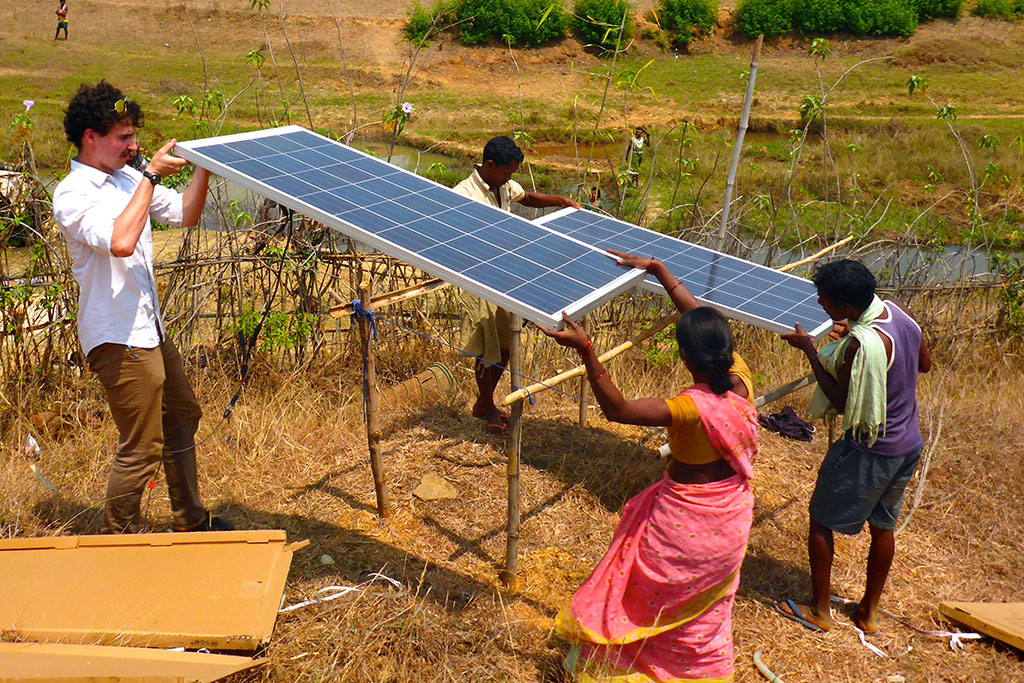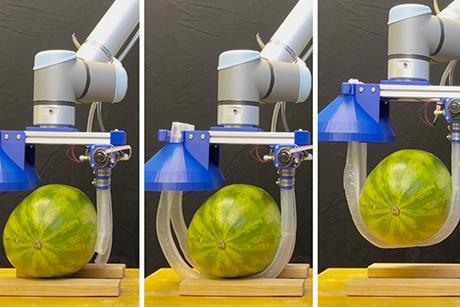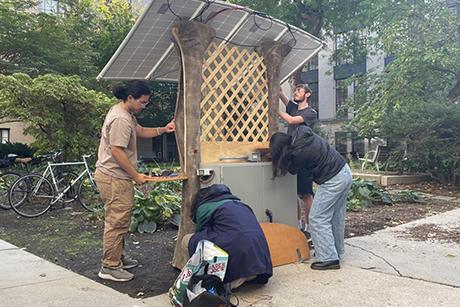How engineering students are seeking to solve major food and water security problems
Food and water are two necessities for survival, but what happens when a changing climate in key agricultural regions threatens crop production? Or when the quality of milk cannot be ensured as it is exchanged between producer and seller?
Seven MIT graduate students studying food and water security issues presented their research and preliminary findings on issues such as these during the MIT Water and Food Security Student Symposium held on Nov. 21. Hosted by the MIT Department of Civil and Environmental Engineering (CEE) and the MIT Abdul Latif Jameel World Water and Food Security Lab (J-WAFS), the event brought together professors and students to discuss food and water challenges and opportunities to address these through research.
Chandra Madramootoo, CEE visiting professor and J-WAFS visiting scholar, curated the event and spoke briefly of the importance of water and food security. “The withdrawal of water varies in different parts of the world. Much larger amounts of water are withdrawn for agriculture compared to industry and domestic uses in South Asia, Middle East, North Africa, Sub-Saharan Africa, Latin America, and East Asia Pacific. This puts stresses on water resources available for food production and our ability to achieve food security. It also puts stress on a very finite resource amongst the other economic and environmental sectors that are competing for that water supply,” Madramootoo highlighted in his opening remarks.
During the event, each student presenter was tasked with conveying a broad overview of his or her research in a five minute presentation. There was a wide range of topics, but each student sought to solve a problem relating to food or water. Presentations addressed research as varied as understanding the impact of an environmental threat to agriculture to developing improved irrigation technology to help smallholder farmers around the world.
Understanding food and water through an environmental lens
Paige Midstokke, a master’s candidate in CEE and a Tata Fellow in Technology and Policy, kicked off the student component of the symposium. Through her research, Midstokke is seeking to improve the drought planning process by researching water security for the state of Maharashtra in India. Since most water planning and management is done at the district level, Midstokke is conducting a case study, focusing on the Aurangabad district.
For her thesis, Midstokke is developing a “vulnerability-scarcity index” that integrates socioeconomic data, pumping rates from observation wells, and geographic information system data. “If you work with the government of India, they have a ton of data and they are often willing to give it to you; you get to decide how to put it all together,” she said. Her index is intended to improve early indicators of drought and thus improve water scarcity planning at the district and local levels.
Anjuli Jain Figueroa, a PhD candidate in CEE, introduced her research by asking if the question of “sustainable agriculture” is an oxymoron. She noted that historically, increased food production has had negative environmental impacts. Her research, entitled “Sustainable agriculture – quantifying the trade-offs between food security and environmental impacts,” uses case studies from India to describe this trend.
During her presentation, Jain Figueroa provided an example of a trade-off she is studying, wherein profit increased for farmers, but there was an unforeseen negative impact. “We see this in a shift that happened with rice. India is growing a lot of rice but it has come at a cost; the cost was nutritional value. Even though families are making more money, the nutritional value for that household decreased. That’s one of the unintended consequences we’re only realizing now,” Jain Figueroa said. She is now working to solve problems like these in her thesis by using a systems approach to study how farmers could increase crop production to meet 2050 population needs, while limiting the negative environmental impacts.
Luke Schiferl, a PhD candidate in CEE, added a global perspective to food and water security. Schiferl looks at how air quality affects crop productivity on a global scale and how these effects can be quantified. In his research project “Contrasting particulate matter and ozone effects on crop production,” he uses crop production simulations and chemistry models to quantify the offsetting effects of ozone and particulate matter on crop productivity. This research can suggest how crop production losses can be properly mitigated by air quality improvements once the effects are understood.
“We can relate ozone and particulate matter effects with known relationships to crop production and basically plot the different effects,” he said. In the future, Schiferl hopes to apply similar research to simulate the effects water and nutrient restrictions have on these air quality effects and predicting crop productivity.
Creating tools and technology to solve food and water security issues
Four student contributors to the symposium presented on technological solutions to various environmental issues. Many of these innovative tools are already in use and tested, ready to make positive changes for food and water security around the world.
Kevin Patrick Simon, a PhD candidate in mechanical engineering, lent the energy perspective to the water and agriculture discussion. Energy is needed to access water sources with pumps, but energy supply from electricity grids and water sources are distributed unequally across India. In rural India, small farmers still use diesel to run their water pumps. Unfortunately, the cost of diesel discourages year-round cultivation in favor of lower-paying jobs during the winter and dry season. Simon is seeking a solution with his research on “High efficiency, low-cost positive displacement pumps for solar irrigation.”
The central question to Simon’s research — “How can we enable people to have better access to water in order to irrigate their land?” — is addressed in part by solar irrigation. He explained the numerous benefits of solar irrigation, including its potential for cost-savings, independence from the electricity grid and environmental sustainability. “It gives small farmers an unprecedented amount of independence and an ability to draw income from their land,” he said.
Pulkit Shamshery, also a PhD candidate in mechanical engineering, is taking a different approach to irrigation by making drip irrigation systems more energy-efficient and more accessible to small farmers. Shamshery noted that 15 percent of India’s food production is dependent on over-exploited water resources; “there is an extreme need for more food with less water, and that’s the motivation for drip irrigation.” Advantages of drip irrigation are increased water savings and higher yields. Additionally, farmers can use less fertilizer by only applying it where it is needed. However, drip irrigation is typically a costly endeavor, which led Shamshery to his project “Low cost, energy-efficient drip irrigation system.”
Along with a research team, Shamshery looked at where the most pressure was being lost in irrigation systems when using them to retrieve water from surface sources, and then figured out how to reduce that pressure loss. The team created an off-grid product to make irrigation more efficient and available at a lower cost. Shamshery’s component is patent-pending and will be licensed, and the pressure loss results in a cut of cost of an off-grid drip system by 50 percent for an acre of land.
“In the United States you can buy milk off the shelf and not worry about any contamination, but that’s not true for developing countries,” said Pranay Jain, Legatum Fellow and PhD candidate in mechanical engineering. Jain highlighted the public health and economic consequences of milk contamination in India, noting that when people don’t trust the quality of milk that is sold to them, the milk industry suffers.
Jain’s research project, “Milk quality analysis for villages in India,” addresses the question: “If milk changes hands so many times before it reaches the consumer, how can these buyers and sellers trust each other?” Jain’s solution was to create an affordable, portable instrument to quickly and accurately determine the quality of milk as it moves through the supply chain from farm to grocery store, and to help improve payment mechanisms. By testing the quality of milk on the spot, “the supply chain simplifies; more farmers opt to sell their milk to processing plants, these plants can get more milk, they will pay the farmer more accurately and both sides benefit.” The device is also powered by mobile phones and collects data; the data collected by the device will be saved in the cloud, allowing for researchers to observe trends and monitor the health of their livestock.
In India, approximately one out of every five crates of produce is lost due to spoilage, but Kendall Nowocin, Legatum Fellow and PhD candidate in electrical engineering and computer science, is tackling that problem with CoolCrop, a storage apparatus for small farmers. The storage unit is about the size of a walk-in closet and extends the freshness of their produce.
CoolCrop is already being piloted through cooperatives involving non-governmental organizations, and their use is augmented with market analytics. Following supply-and-demand, farmers get the most value for their crops if they are in markets with fewer competitors. CoolCrop fills this void by providing market analytics to small farmers, so they know which markets will increase their profit. Explaining their business model, he said that they “can extract an initial profit that pays for the cold storage and increases the value for the farmer.”
CEE Professor Dennis McLaughlin noted in the closing remarks that although most of the research shared at the symposium was centered on India, other developing areas around the world are dealing with similar issues.
The MIT Water and Food Security Student Symposium was the final component of a seminar series hosted by Chandra Madramootoo. Commenting that on the importance of water security, he said “I think it’s important when we think about water in the broader context, to think about the competition that’s placed between agricultural water and other sources of water. It’s this competing pressure for resources that we need to think about.”



